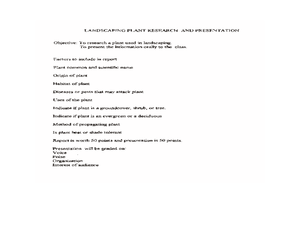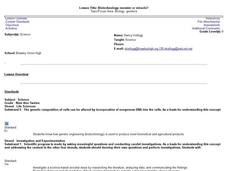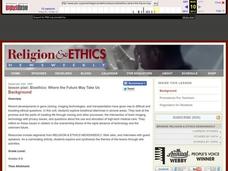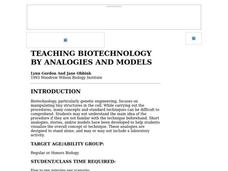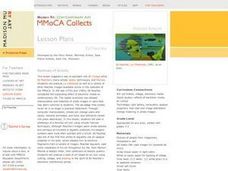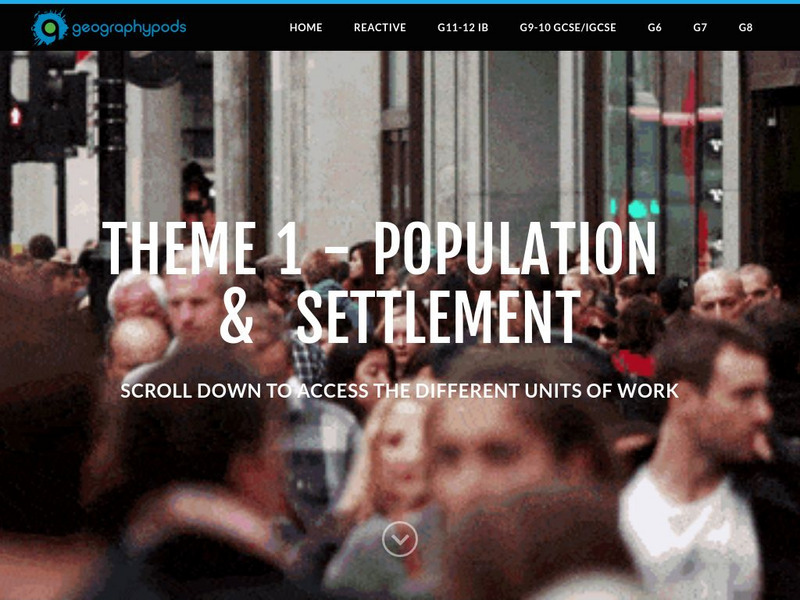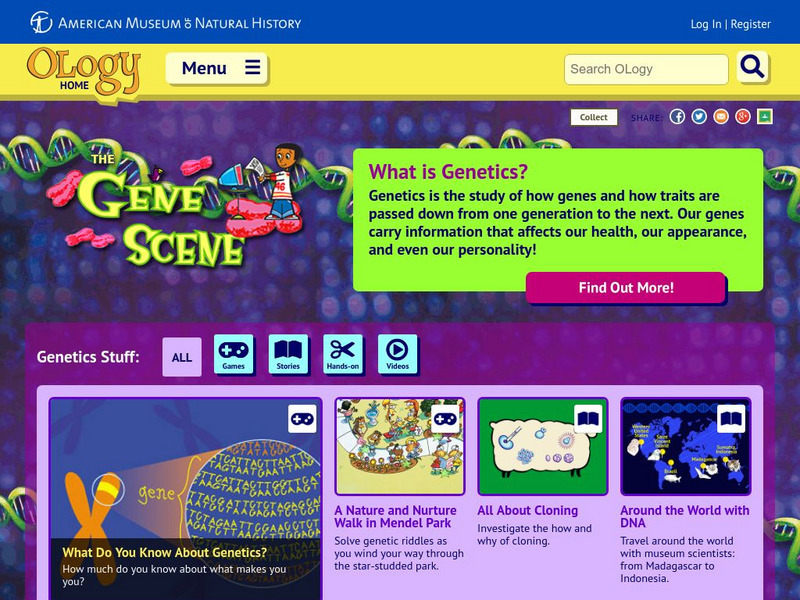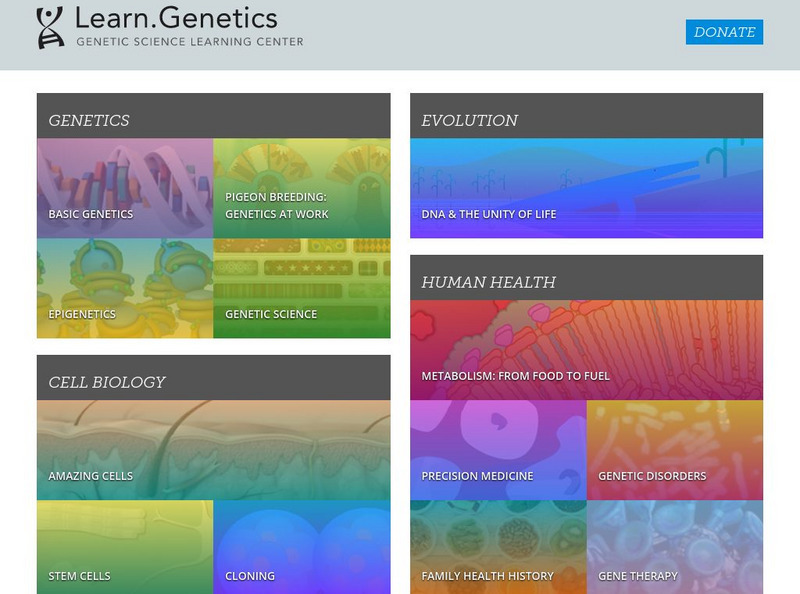Curated OER
Human Genetics and Heredity
Students choose topics for research based on human genetics and heredity. They conduct research via the Internet and write a brief explanation of the milestone in genetics and heredity and attach it to a class timeline. They share...
Curated OER
Plants, Plants, and More Plants
Students examine several types of plants. In this plant lesson, students complete activities that require them to identify types of plants, chart plant anatomy, and explain plant propagation.
Curated OER
Biotechnology: Monster or Miracle
Students explore biotechnology. For this scenario-based lesson, students take a survey on what they know about genetic engineering, view a PowerPoint, and conduct a web quest. Students will then be placed in groups, and produce one of...
Curated OER
An Opportunity to access and use the Internet for Research and Study.
Students analyze how to begin hands on research for science projects and experiments. They develop a problem and design a systematic effort to resolve it.
Teach Engineering
Don't Be a Square
If Parseltongue is a genetic trait, what is the probability a wizard will inherit the ability to speak Parseltongue? Scholars investigate magical and biological genetics with Punnett squares.
Curated OER
Bioethics: Where the Future May Take Us
Students analyze ethical issues related to technology, medicine, and reproduction. In this ethics lesson, students research selected bioethics issues and discuss their risks and benefits. Students present their research findings to their...
Curated OER
The Challenge to Deliver Insulin
Students study the types of diabetes and why insulin is important. For this diabetes lesson students build molecular models and create a healthy lifestyle plan.
Curated OER
Gel Electrophoresis
Students conduct a variety of experiments to explore gel electrophoresis. In this biology instructional activity, explain how this process separate DNA and RNA. They discuss the practical applications of this method.
Curated OER
Jurassic Park Debate
Students research behavior, phsyiology, and ecology of dinoaurs. Students role-play as scientific specialists such as geneticists and ecologists. They present their research findings in a research paper.
Curated OER
Frankenstein
Students use an outline of the story "Frankenstein" to identify mistakes in English. They practice making corrections to make the sentence correct. They answer questions to end the lesson plan.
Curated OER
Teaching Biotechnology By Analogies And Models
Students explore biotechnology by analogies and models. They read several provided scenarios and answer questions to discover some basic concepts of biotechnology.
Curated OER
The Dragon Curve Fractal
Students identify the properties of a dragon curve. In this geometry lesson, students identify sequences and patterns as they solve fractals. They investigate patterns found in nature.
Curated OER
Re-Viewpoints From 2002
Students explore how editorials use various devices to convey a message to a reader. They select key news topics from 2002 and write their own editorials.
Curated OER
Genetic Engineering
Learners examine the advantages and disadvantages of genetic engineering. In this genetics lesson students simulate the genetic engineering of a human insulin gene.
Curated OER
Direct Speech
Young scholars explore characteristics of a good speech. They use speech marks to demarcate direct speech. Students read a report and rewrite it, using verbs that describe people speaking.
Curated OER
The Environment and Animals
In this environment and animals worksheet, 7th graders match ten pictures with their actual titles, answer seven statements as true and false, and discuss six questions together.
Curated OER
Teaching Biotechnology by Analogies and Models
Students examine analogies and create models to help visualize the concept and technique of basic biotechnology. Common scenarios are used to explain the complex procedures of genetic engineering.
Curated OER
Ed Paschke
Students examine and discuss the artistic style and techniques of the artist Ed Paschke. They analyze various works of art by Ed Paschke, then choose an icon from art history and alter a photocopy of it using scissors and collage materials.
Rong-Chang ESL
Esl: English for Intermediate Learners (2): Cloning Pets
A learning module geared toward English as a Second Language Learners. Students read and/or listen to a short text entitled "Cloning Pets" and click on the links below to increase comprehension and vocabulary skills. Students can...
The Association of the British Pharmaceutical Industry
Abpi: Active Science: Genes and Inheritance
An interactive website that explores information about genes, mitosis, meiosis, cloning, and gene mutation. Concepts are discussed in detail with an interactive glossary and animations. At the end of each section quick questions are...
Geographypods
Geographypods: Theme 1: Population and Settlement
A rich collection of highly engaging learning modules on topics related to population and settlement. Covers six main areas - population growth, population change, population migration, land use, settlement characteristics and patterns,...
American Museum of Natural History
American Museum of Natural History: O Logy: Genetics
This site from American Museum of Natural History focuses on Genetics. It defines genetics and provides links to games, stories, videos, and hands-on activities on the topic.
University of Utah
University of Utah: Genetic Science Learning Center: The Basics and Beyond
This website offers a clear definition of the science of Genetics, highlighting DNA and genes. There is a neat, easy-to-understand animated tour of the basics and an opportunity to go inside an animated cell. Student can build a DNA...
The Association of the British Pharmaceutical Industry
Abpi: Biotechnology
Students read through a complete, interactive lesson on biotechnology. An activity at the end allows students to research and present arguments for or against statements about the ethics of gene therapy and gene manipulation.



